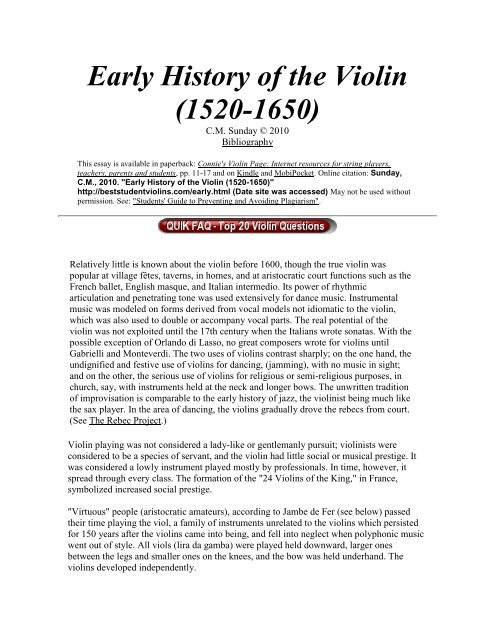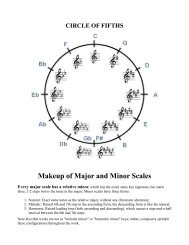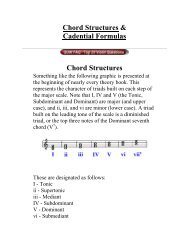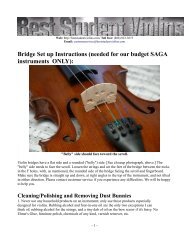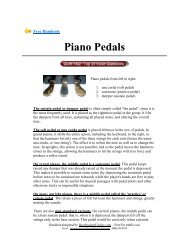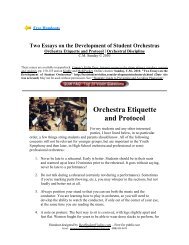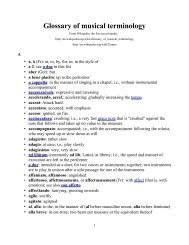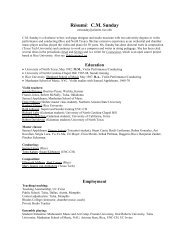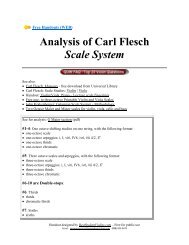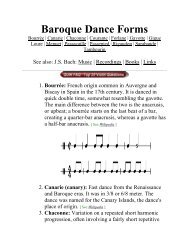Early History of the Violin (1520-1650) - Best Student Violins
Early History of the Violin (1520-1650) - Best Student Violins
Early History of the Violin (1520-1650) - Best Student Violins
Create successful ePaper yourself
Turn your PDF publications into a flip-book with our unique Google optimized e-Paper software.
<strong>Early</strong> <strong>History</strong> <strong>of</strong> <strong>the</strong> <strong>Violin</strong><br />
(<strong>1520</strong>-<strong>1650</strong>)<br />
C.M. Sunday © 2010<br />
Bibliography<br />
This essay is available in paperback: Connie's <strong>Violin</strong> Page: Internet resources for string players,<br />
teachers, parents and students, pp. 11-17 and on Kindle and MobiPocket. Online citation: Sunday,<br />
C.M., 2010. "<strong>Early</strong> <strong>History</strong> <strong>of</strong> <strong>the</strong> <strong>Violin</strong> (<strong>1520</strong>-<strong>1650</strong>)"<br />
http://beststudentviolins.com/early.html (Date site was accessed) May not be used without<br />
permission. See: "<strong>Student</strong>s' Guide to Preventing and Avoiding Plagiarism".<br />
Relatively little is known about <strong>the</strong> violin before 1600, though <strong>the</strong> true violin was<br />
popular at village fêtes, taverns, in homes, and at aristocratic court functions such as <strong>the</strong><br />
French ballet, English masque, and Italian intermedio. Its power <strong>of</strong> rhythmic<br />
articulation and penetrating tone was used extensively for dance music. Instrumental<br />
music was modeled on forms derived from vocal models not idiomatic to <strong>the</strong> violin,<br />
which was also used to double or accompany vocal parts. The real potential <strong>of</strong> <strong>the</strong><br />
violin was not exploited until <strong>the</strong> 17th century when <strong>the</strong> Italians wrote sonatas. With <strong>the</strong><br />
possible exception <strong>of</strong> Orlando di Lasso, no great composers wrote for violins until<br />
Gabrielli and Monteverdi. The two uses <strong>of</strong> violins contrast sharply; on <strong>the</strong> one hand, <strong>the</strong><br />
undignified and festive use <strong>of</strong> violins for dancing, (jamming), with no music in sight;<br />
and on <strong>the</strong> o<strong>the</strong>r, <strong>the</strong> serious use <strong>of</strong> violins for religious or semi-religious purposes, in<br />
church, say, with instruments held at <strong>the</strong> neck and longer bows. The unwritten tradition<br />
<strong>of</strong> improvisation is comparable to <strong>the</strong> early history <strong>of</strong> jazz, <strong>the</strong> violinist being much like<br />
<strong>the</strong> sax player. In <strong>the</strong> area <strong>of</strong> dancing, <strong>the</strong> violins gradually drove <strong>the</strong> rebecs from court.<br />
(See The Rebec Project.)<br />
<strong>Violin</strong> playing was not considered a lady-like or gentlemanly pursuit; violinists were<br />
considered to be a species <strong>of</strong> servant, and <strong>the</strong> violin had little social or musical prestige. It<br />
was considered a lowly instrument played mostly by pr<strong>of</strong>essionals. In time, however, it<br />
spread through every class. The formation <strong>of</strong> <strong>the</strong> "24 <strong>Violin</strong>s <strong>of</strong> <strong>the</strong> King," in France,<br />
symbolized increased social prestige.<br />
"Virtuous" people (aristocratic amateurs), according to Jambe de Fer (see below) passed<br />
<strong>the</strong>ir time playing <strong>the</strong> viol, a family <strong>of</strong> instruments unrelated to <strong>the</strong> violins which persisted<br />
for 150 years after <strong>the</strong> violins came into being, and fell into neglect when polyphonic music<br />
went out <strong>of</strong> style. All viols (lira da gamba) were played held downward, larger ones<br />
between <strong>the</strong> legs and smaller ones on <strong>the</strong> knees, and <strong>the</strong> bow was held underhand. The<br />
violins developed independently.
Though hybrid instruments continued to exist some time after <strong>the</strong> emergence <strong>of</strong> <strong>the</strong> violin,<br />
its origins are said to have been <strong>the</strong> rebec, <strong>the</strong> Renaissance fiddle, and <strong>the</strong> lira da braccio.<br />
The rebec dates back to <strong>the</strong> 13th century and consisted <strong>of</strong> a family <strong>of</strong> treble (discant), altotenor,<br />
and bass instruments. It was pear-shaped, and without a soundpost; <strong>the</strong> neck and<br />
pegbox were integral parts <strong>of</strong> <strong>the</strong> instrument. There were no overhanging edges, no frets,<br />
and <strong>the</strong> three strings were tuned in fifths. The sound <strong>of</strong> this instrument is said to have been<br />
smaller than <strong>the</strong> violins, with a nasal, oboe-like quality. The bow was held overhand. The<br />
Renaissance fiddle, c. 1500, had five strings, (one a drone), and frets. Shaped like <strong>the</strong> violin,<br />
it had a top and back with connecting ribs, a separate neck and fingerboard, and it was in <strong>the</strong><br />
soprano register. Close to <strong>the</strong> violin body outline, <strong>the</strong> lira da braccio was designed in several<br />
sizes; its bouts made it easier to bow <strong>the</strong>n <strong>the</strong> rebec. Like <strong>the</strong> violin, it had an arched back<br />
and top, overlapping edges, ribs, a sound post, and f or c-shaped sound holes. It had seven<br />
strings, two <strong>of</strong> which were drones.<br />
By a kind <strong>of</strong> organic, triangulative process between craftsmen, players, and composers,<br />
early violins came into existence around <strong>1520</strong> in nor<strong>the</strong>rn Italy. The 4-stringed "true" violin<br />
family was complete in its basic structural features - though not standardized - around 1550.<br />
(Jambe de Fer described <strong>the</strong>m explicitly in his Epitome Musical. Lyons, 1556.) The<br />
controversy over who invented <strong>the</strong> first violin is probably not answerable; Gasparo da Saló<br />
was a candidate, as were several Brescian craftsmen. It is now generally accepted that da<br />
Saló was not <strong>the</strong> inventor since he wasn't born until 1540. Better candidates are Giovan<br />
Giacoba dalla Corna and Zanetto de Michelis da Montichiaro, both born in <strong>the</strong> 1480s. It is,<br />
however, clear that Andrea Amati perfected <strong>the</strong> form. Similar instruments in France and<br />
Poland suggest <strong>the</strong> far-reaching influence <strong>of</strong> <strong>the</strong> Italian Renaissance. Native schools <strong>of</strong><br />
violin-making existed in Cremona and Brescia, and also in Paris and Lyon; but this had to<br />
do with <strong>the</strong> trade routes (and <strong>the</strong> silk trade) from Venice to Paris. Changes in <strong>the</strong> violin after<br />
1600 were largely decorative.<br />
<strong>Early</strong> violins could be ei<strong>the</strong>r 1/4" shorter or 1/2" longer than <strong>the</strong> modern 14" (35.5 cm)<br />
instrument. Pegboxes sometimes ended in carved heads instead <strong>of</strong> scroll. The neck is<br />
shorter, projects at right angles from <strong>the</strong> body, and <strong>the</strong> fingerboard is shorter (by 2 1/2"),<br />
with a wedge between neck and fingerboard. The bridge is both lower and rounder. Open<br />
strings were used when possible, and <strong>the</strong> more yielding hair <strong>of</strong> <strong>the</strong> old bow made it easier to<br />
sustain triple stops at forte. The modern chinrest was unknown, and <strong>the</strong> violin was held at<br />
<strong>the</strong> neck; perspiration marks on ei<strong>the</strong>r side <strong>of</strong> <strong>the</strong> tailpiece indicate <strong>the</strong> chin held <strong>the</strong><br />
instrument <strong>the</strong>re. In dance music, <strong>the</strong> instrument was <strong>of</strong>ten or usually held lower.<br />
While <strong>the</strong> Tourte bow rendered <strong>the</strong> older bows obsolete and <strong>of</strong> no commercial value<br />
(<strong>the</strong>refore none exist today), <strong>the</strong> older violins were carefully preserved, though apart from<br />
rare exceptions, usually opened and altered with modern fittings, including neck,<br />
fingerboard, bridge, bass-bar, sound-post, strings, chinrest and E tuner. Because <strong>of</strong> <strong>the</strong><br />
lower tension, <strong>the</strong> old bass bar was shorter and lighter and <strong>the</strong> soundpost thinner. <strong>Early</strong><br />
(convex) bows varied greatly in shape, and <strong>the</strong> modern frog was predated by various<br />
attempted solutions to holding <strong>the</strong> narrower ribbon <strong>of</strong> hair in place. The modern Tourte<br />
bow, with its logarithmic inward curvature, cannot be pressed too deeply in <strong>the</strong> middle, or
<strong>the</strong> wood will be scraped by <strong>the</strong> strings. Baroque bows did not have this problem, though<br />
<strong>the</strong> degree <strong>of</strong> curvature began to decrease at <strong>the</strong> end <strong>of</strong> <strong>the</strong> 17th century.<br />
<strong>Early</strong> in <strong>the</strong> 16th century <strong>the</strong> advantages <strong>of</strong> combining from its predecessors <strong>the</strong> greater<br />
sonority, <strong>the</strong> easier and more efficient playing and tuning, and <strong>the</strong> more sensible fingering<br />
were discovered. The new instruments were easier to carry at dances, weddings and<br />
mummeries (<strong>the</strong>atrical productions including masked figures), and <strong>the</strong>ir sound "carried<br />
well," which was important for dancing. Many musicians played both old and newer<br />
instruments, and technical practices were borrowed from <strong>the</strong> old.<br />
Though <strong>the</strong> Baroque violin was considered "beaucoup plus rude en son" (Jambe de Fer,<br />
1556), it was, by our standards, less intense, purer, reedier and more transparent. Gimping,<br />
or <strong>the</strong> practice <strong>of</strong> using gut strings overspun with fine copper or silver wire, was not<br />
practiced until <strong>the</strong> early 18th century. Strings were gut, (for this reason <strong>the</strong> G was<br />
unresponsive, and seldom used), and gauges were not known, though violin strings were<br />
stronger and thicker than viol strings.<br />
<strong>Early</strong> Baroque violin music, (<strong>of</strong> which <strong>the</strong>re is very little before <strong>the</strong> turn <strong>of</strong> <strong>the</strong> century, and<br />
that in <strong>the</strong> last 20 years, and not idiomatic), seldom ventures beyond <strong>the</strong> third position. (The<br />
first written music designated with a violin part is that <strong>of</strong> a Royal French wedding in 1581.)<br />
Therefore <strong>the</strong> usual range was d'-b" or c", (since <strong>the</strong> low G was seldom used)--<strong>the</strong> typical<br />
range <strong>of</strong> <strong>the</strong> soprano voice. Though lute players were encouraged to play "beyond <strong>the</strong> frets,"<br />
<strong>the</strong> short, fat neck <strong>of</strong> <strong>the</strong> violin did not encourage playing in upper positions, and made it<br />
more difficult to use <strong>the</strong> fourth finger; <strong>the</strong> momentary robustness <strong>of</strong> open strings was not<br />
uncommon.<br />
There were no accepted standards <strong>of</strong> pitch; string players were regularly told to tune <strong>the</strong>ir<br />
instruments up as high as <strong>the</strong>y would go, (Agricola, 1528) and pitch varied from town to<br />
town and even from one organ to ano<strong>the</strong>r within a church. Nor was <strong>the</strong>re any equally<br />
tempered tuning system. There was probably a distinction between harmonic pairs <strong>of</strong> notes,<br />
but it worked opposite to what it is today. (For example, violinists today think <strong>of</strong> F#, say, as<br />
a sort <strong>of</strong> leading tone to G, and <strong>the</strong> F# is played higher than <strong>the</strong> upper enharmonic. The<br />
reverse was true in <strong>the</strong> Baroque.)<br />
Nor was <strong>the</strong>re any standardization in <strong>the</strong> way <strong>the</strong> bow <strong>of</strong> <strong>the</strong> violin was held. As mentioned<br />
above, <strong>the</strong> violin was held in a more relaxed position while dance music was played on <strong>the</strong><br />
breast or arm, (hence, <strong>the</strong> distinction "lira da braccio,") and held at <strong>the</strong> neck for more<br />
serious music. The bow was held in two styles; that <strong>of</strong> <strong>the</strong> French -- very different than <strong>the</strong><br />
modern way -- with <strong>the</strong> thumb under <strong>the</strong> hair and not between <strong>the</strong> bow and stick, as in <strong>the</strong><br />
second, or Italian way, which is said to be entirely similar to modern teaching, such as that<br />
<strong>of</strong> Carl Flesch.<br />
The animated styles <strong>of</strong> dancing and <strong>the</strong> short bows were made for an articulated style,<br />
unlike <strong>the</strong> "endless bow" idea <strong>of</strong> modern practice. Vibrato was not continuous, but used as<br />
expressive ornamentation. (Our wide and continuous vibrato would have been disruptive.)<br />
No fingerings have been found before 1600 even for such simple music that exists. Playing
in <strong>the</strong> higher positions seems unlikely, considering <strong>the</strong> way <strong>the</strong> instrument was held in<br />
dance music. (From <strong>the</strong> modern viewpoint, second position is excellent to use, particularly<br />
in sequential passages.) However, <strong>the</strong>re was more to violin music than <strong>the</strong> extant pieces<br />
indicate. So much money was spent on fine instruments, and this is not compatible with <strong>the</strong><br />
idea <strong>of</strong> primitive instruments and technique. Orchestral and chamber parts were not required<br />
to go above <strong>the</strong> third position, but virtuoso pieces were ano<strong>the</strong>r matter. Some advance<br />
technique may have been lost because it was considered a pr<strong>of</strong>essional secret.<br />
After 1600, violin players built on <strong>the</strong> technical achievements <strong>of</strong> <strong>the</strong> viol players, and <strong>the</strong><br />
practice advanced rapidly. Monteverdi's operatic writing included idiomatic sections with<br />
comparatively sophisticated technique. After 1610, <strong>the</strong> advent <strong>of</strong> <strong>the</strong> violin sonata, <strong>the</strong><br />
formative period <strong>of</strong> violin practice ended and a new technical virtuosity came about in<br />
response to an age which produced Galileo, Kepler, Bacon, Descartes, Newton and Harvey.<br />
(And anticipated by da Vinci and manifested in <strong>the</strong> Reformation.) The rise <strong>of</strong> opera and<br />
instrumental forms not subordinate to <strong>the</strong> voice is analogous to <strong>the</strong> gradual subordination <strong>of</strong><br />
religious to secular authority. Musicians were usually lower-middle class, and traditionally<br />
from long lines <strong>of</strong> musical families; socially, <strong>the</strong> lot <strong>of</strong> <strong>the</strong> musician varied from little better<br />
than beggar to that <strong>of</strong> <strong>the</strong> Royal musicians, who enjoyed fine clo<strong>the</strong>s, salaries, and some<br />
measure <strong>of</strong> security. Even <strong>the</strong> ordinary musician was protected by unions in both France and<br />
England. During <strong>the</strong> early 17th century, <strong>the</strong> preeminence <strong>of</strong> violin making continued in<br />
Brescia and Cremona, and Biago Marini <strong>of</strong> Brescia (1597-1665) was <strong>the</strong> most important<br />
composer <strong>of</strong> violin music <strong>of</strong> <strong>the</strong> time; he and contemporaries such as Dario Castello,<br />
Salomone Rossi, Maurizio Cazzati, and Marco Uccellini experimented with purely<br />
instrumental forms. The sonata -- most advanced <strong>of</strong> instrumental forms -- came from <strong>the</strong> old<br />
practice <strong>of</strong> doubling vocal parts <strong>of</strong> a chanson, one <strong>of</strong> <strong>the</strong> principle Renaissance forms.<br />
Marini's work is calculated in terms <strong>of</strong> <strong>the</strong> violin; <strong>the</strong> rapid passages fit <strong>the</strong> hand,<br />
particularly in descending or ascending sequences and arpeggios and broken chords<br />
involving playing back and forth across strings. Marini used <strong>the</strong> "stile concitato," predating<br />
Monteverdi, and experimented extensively in double - and triple-stops. (Capriccio per<br />
Sonare il <strong>Violin</strong>o con tre corde a mondo di lira, Op. 8. ) His scordatura was written at pitch,<br />
leaving <strong>the</strong> player to work out <strong>the</strong> fingerings. (Most later scordatura works were written in<br />
"hand-grip" notation.)<br />
O<strong>the</strong>r special affects <strong>of</strong> <strong>the</strong> Baroque were <strong>the</strong> use <strong>of</strong> pizzicati like that used in Monteverdi's<br />
operas (not called such), <strong>the</strong> mute, col legno, sul ponticello and sulla tastiera. Harmonics<br />
may or may not have been known, and <strong>the</strong> matter is not settled. Two types <strong>of</strong> ornaments<br />
were used; (a) those with specific names, such as <strong>the</strong> trill, mordent, vibrato and (b) those<br />
which constituted some improvised melodic formulae. The practice <strong>of</strong> adding passages to<br />
<strong>the</strong> written score was so common that sometimes composers felt it was necessary to add<br />
"come sta senza passaggi." Since <strong>the</strong> demands <strong>of</strong> dance music were chiefly rhythmic, it is<br />
not known if violin practice included ornamental elaboration like <strong>the</strong> diminutions and<br />
passaggi <strong>of</strong> Francesco Rogniono. (Selva de varii passaggi secondo l'uso moderno. Milan,<br />
1620.)<br />
All <strong>of</strong> <strong>the</strong>se physical characteristics contributed to a sound which was altoge<strong>the</strong>r less
assertive, less massive, and more edgy, pungent, and colorful. "Just as <strong>the</strong> painter imitates<br />
nature," (wrote Ganasssi, in "Regola Rubertina," <strong>the</strong> only detailed treatise on string playing<br />
in <strong>the</strong> 16th century; Ganassi was a pr<strong>of</strong>essional viol player,) "so wind and string players<br />
should imitate <strong>the</strong> human voice." Vibrato on long notes must have been combined with<br />
dynamic nuance, and <strong>the</strong> messa di voce probably carried over into string practice.<br />
Though if one sees a lot <strong>of</strong> dynamic markings in a Baroque piece, and it may be inferred<br />
that <strong>the</strong>y were put <strong>the</strong>re by <strong>the</strong> editor, <strong>the</strong>y never<strong>the</strong>less existed from <strong>the</strong> start <strong>of</strong> <strong>the</strong> period<br />
and increased in frequency throughout. Performers considered <strong>the</strong>m hints, however, and<br />
dynamics are properly used for structural shaping, to delineate <strong>the</strong> form by terraced fortes<br />
and pianos, and to mold <strong>the</strong> texture within <strong>the</strong> form. This may cause a built-in echo effect,<br />
as in some <strong>of</strong> Marini's sonatas, particularly <strong>the</strong> Sonata in Echo for three violins, Op. 8.<br />
(Composed in Germany and published in Vienna. Marini was concertmaster to Schutz.)<br />
Agogic accents were probably used for expression, but no mention is made <strong>of</strong> <strong>the</strong> audible<br />
shifting or portamento so usual in modern playing; <strong>the</strong> practice was that several shifts were<br />
preferred over one big one. Marini's greatest contribution lies in his purposeful adaptation <strong>of</strong><br />
vocal style to idiomatic violin writing. Affetti Musicali, <strong>the</strong> title <strong>of</strong> Op. 1 (1617) may be said<br />
to indicate that <strong>the</strong> affections could be moved (that all-embracing Baroque ideal) by means<br />
<strong>of</strong> instruments alone. The Sonate in d-moll (a sonata for violin and cello with organ or<br />
harpsichord) well illustrates <strong>the</strong> Baroque form, idiomatic composition, and <strong>the</strong> use <strong>of</strong> affetti.<br />
The sonata is in three movements: Grave/Allego/Moderate. All three movements are<br />
imitative; that is, <strong>the</strong> slow (and serious) opening (white note) phrases in <strong>the</strong> cello are<br />
answered rhythmically and melodically by <strong>the</strong> violin in measures 8-11. This imitative<br />
faculty is repeated one beat apart in 16th notes (idiomatic to <strong>the</strong> violin, as <strong>the</strong>y lay so well<br />
within <strong>the</strong> hand and would, I think, be unlikely as vocal exercise), at measures 17, 24 and<br />
26.<br />
This practice is continued in <strong>the</strong> Seconda part, <strong>the</strong> cello's opening phrases repeated by <strong>the</strong><br />
violin in measure 35, 39, 48. Though diminution and affetti may certainly have been<br />
included at moments not suggested by <strong>the</strong> score, <strong>the</strong>y are specifically suggested in this<br />
movement by <strong>the</strong> fanfare-like configuration <strong>of</strong> measures 59-72. (Dynamic markings are<br />
probably <strong>the</strong> editor's.) How this solo actually was played can only be deduced according to<br />
<strong>the</strong> skill and imagination <strong>of</strong> <strong>the</strong> performer.<br />
Movement three (terza parte) is, again, imitative, but unlike <strong>the</strong> o<strong>the</strong>r movements, is in<br />
triple meter. Hemiola is used characteristically in measures 75, 90-94 and 100-102. Starting<br />
around measure 90, a brilliant, fiery, "concitato" tension is built, culminating in <strong>the</strong> high c-<br />
b-d-b 16th note figure in <strong>the</strong> violin, measure 95, which calms down slowly in <strong>the</strong> alternating<br />
eighth note-quarter note figures, measures 96-98.<br />
The Baroque ideal is an arch <strong>of</strong> sound, appropriately well-sustained and well-proportioned.<br />
For Baroque music to get airborne, <strong>the</strong> line must soar. The bow is like <strong>the</strong> breath <strong>of</strong> a singer.<br />
To quote Donington (p. 88): "Phrases generally go to a peak note, which is <strong>of</strong>ten though not<br />
always <strong>the</strong> highest note, and <strong>the</strong>n relax to a note given away at <strong>the</strong> end. There is <strong>the</strong> unit;<br />
that much, and no less nor more, is <strong>the</strong> phrase; and it is for our own musicianship to
ecognize <strong>the</strong> fact. Nothing in <strong>the</strong> notation and nothing in <strong>the</strong> historical evidence, is going to<br />
show us <strong>the</strong> pattern if our own musicianship does not." To achieve this, <strong>the</strong> modern violinist<br />
(with modern instrument) would have to slow down <strong>the</strong> bow, use less <strong>of</strong> it, and play into <strong>the</strong><br />
string with <strong>the</strong> hair a little flatter and near <strong>the</strong> bridge. Donnington remarks: it can be done.<br />
Bibliography<br />
Baroque Music, Claude V. Palisca. 2nd Edition. Prentice-Hall. N.J. 1981, pp. 145-6.<br />
The Concise Oxford Dictionary <strong>of</strong> Music, Michael Kennedy. 3rd Edition. Oxford<br />
University Press. London. 1980. pp. 608.<br />
Historical Anthology <strong>of</strong> Music, Archibald T. Davidson and Will Apel. Harvard University<br />
Press. Cambridge, Mass. 1950. pp. 30 and 281.<br />
A <strong>History</strong> <strong>of</strong> Western Music, Donald Jay Grout. [3rd Edition with Claude V. Palisca.] W.<br />
W. Norton & Co., Inc. New York. 1973. pp. 293-40, 334-5. Newest ed. <strong>of</strong> <strong>the</strong> Grout, 8th<br />
ed., Burkholder<br />
The <strong>History</strong> <strong>of</strong> <strong>Violin</strong> Playing from its Origins to 1761 and its Relationship to <strong>the</strong> <strong>Violin</strong><br />
and <strong>Violin</strong> Music, David D. Boyden. Oxford University Press. 1965. pp. 2-189.<br />
The Grove Dictionary <strong>of</strong> Musical Instruments, edited by Stanley Saide. MacMillan Press,<br />
Ltd. London. 1984. Vol. 3, pp. 767-773.<br />
The Oxford <strong>History</strong> <strong>of</strong> Music, Vol. III. "The Music <strong>of</strong> <strong>the</strong> 17th Century," C. Hubert H.<br />
Parry. Oxford. 1902. p. 308.<br />
Sonata Per Due <strong>Violin</strong>i Und Basso Continuo (1665). Hortus Musicus 143.l Bärenreiter-<br />
Verlag Kassel und Basel. Germany. 1957.<br />
Sonate D-Moll für <strong>Violin</strong>e, Streichbass (Gambe oder <strong>Violin</strong>cello) Und Basso Continuo,<br />
Biagio Marini. Hortus Musicus 129. Bärenreiter-Verlag Kassel und Basel. Germany. 1955.<br />
String Playing in Baroque Music, Robert Donington. Charles Scribner's & Sons. New York.<br />
1977.


